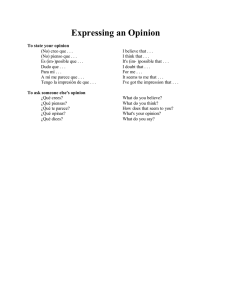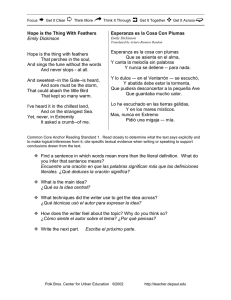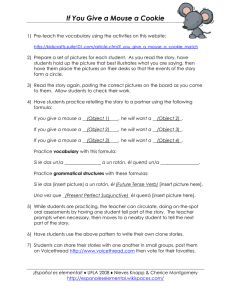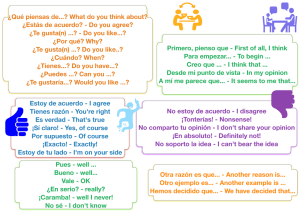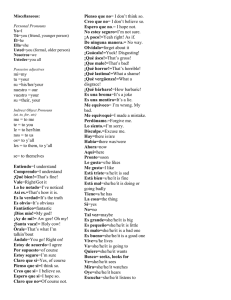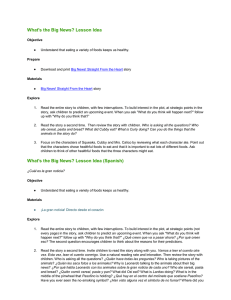Ratón y Cocodrilo - Houghton Mifflin Harcourt
Anuncio
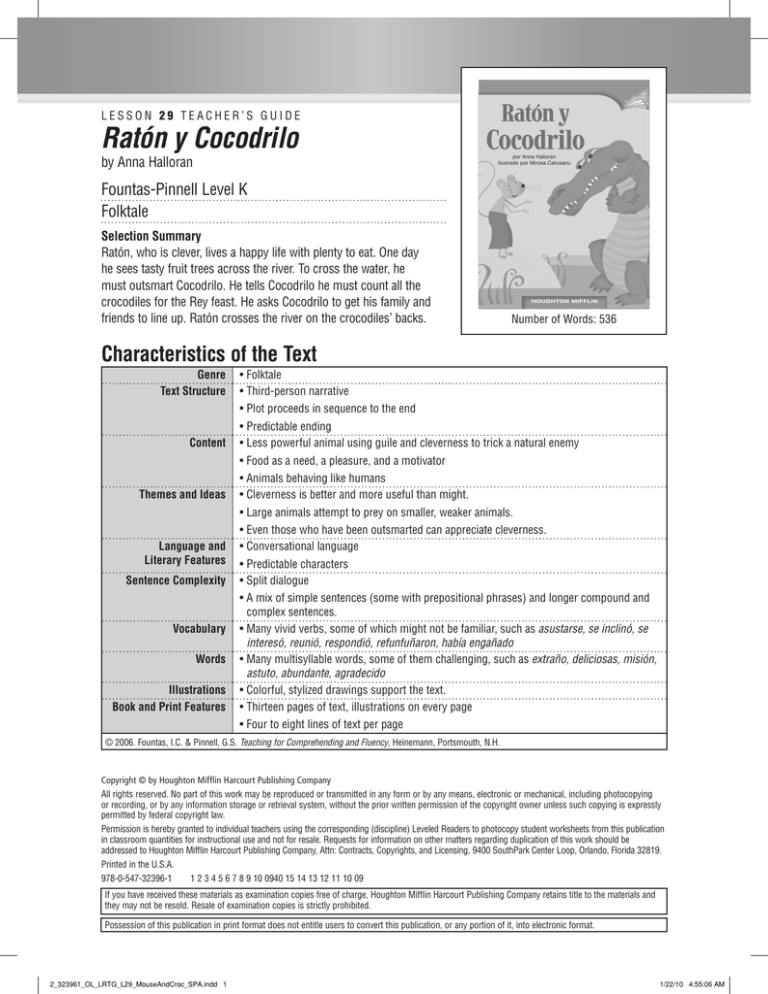
Nivel: L EDL: 20–24 Género: Cuento folklórico Estrategia: Resumir LESSON 29 TEACHER’S GUIDE Ratón y Cocodrilo Destreza: Comprender a los personajes Número de palabras: 534 by Anna Halloran por Anna Halloran ilustrado por Mircea Catusanu 2.6.4 Fountas-Pinnell Level K Folktale HOUGHTON MIFFLIN Libritos nivelados en línea Selection Summary Ratón, who is clever, lives a happy life with plenty to eat. One day he sees tasty fruit trees across the river. To cross the water, he must outsmart Cocodrilo. He tells Cocodrilo he must count all the crocodiles for the Rey feast. He asks Cocodrilo to get his family and friends to line up. Ratón crosses the river on the crocodiles’ backs. 1034906 001_2_046138_LR6_4OL_SPA_COVER_R1 1 H O U G H T O N MI F F L I N Number of Words: 536 4/14/08 11:11:02 AM Characteristics of the Text Genre Text Structure Content Themes and Ideas Language and Literary Features Sentence Complexity Vocabulary Words Illustrations Book and Print Features • Folktale • Third-person narrative • Plot proceeds in sequence to the end • Predictable ending • Less powerful animal using guile and cleverness to trick a natural enemy • Food as a need, a pleasure, and a motivator • Animals behaving like humans • Cleverness is better and more useful than might. • Large animals attempt to prey on smaller, weaker animals. • Even those who have been outsmarted can appreciate cleverness. • Conversational language • Predictable characters • Split dialogue • A mix of simple sentences (some with prepositional phrases) and longer compound and complex sentences. • Many vivid verbs, some of which might not be familiar, such as asustarse, se inclinó, se interesó, reunió, respondió, refunfuñaron, había engañado • Many multisyllable words, some of them challenging, such as extraño, deliciosas, misión, astuto, abundante, agradecido • Colorful, stylized drawings support the text. • Thirteen pages of text, illustrations on every page • Four to eight lines of text per page © 2006. Fountas, I.C. & Pinnell, G.S. Teaching for Comprehending and Fluency, Heinemann, Portsmouth, N.H. Copyright © by Houghton Mifflin Harcourt Publishing Company All rights reserved. No part of this work may be reproduced or transmitted in any form or by any means, electronic or mechanical, including photocopying or recording, or by any information storage or retrieval system, without the prior written permission of the copyright owner unless such copying is expressly permitted by federal copyright law. Permission is hereby granted to individual teachers using the corresponding (discipline) Leveled Readers to photocopy student worksheets from this publication in classroom quantities for instructional use and not for resale. Requests for information on other matters regarding duplication of this work should be addressed to Houghton Mifflin Harcourt Publishing Company, Attn: Contracts, Copyrights, and Licensing, 9400 SouthPark Center Loop, Orlando, Florida 32819. Printed in the U.S.A. 978-0-547-32396-1 1 2 3 4 5 6 7 8 9 10 0940 15 14 13 12 11 10 09 If you have received these materials as examination copies free of charge, Houghton Mifflin Harcourt Publishing Company retains title to the materials and they may not be resold. Resale of examination copies is strictly prohibited. Possession of this publication in print format does not entitle users to convert this publication, or any portion of it, into electronic format. 2_323961_OL_LRTG_L29_MouseAndCroc_SPA.indd 1 1/22/10 4:55:06 AM Ratón y Cocodrilo by Anna Halloran Build Background Help children use their knowledge of animal stories and trickster tales to build interest in the story. Ask questions such as the following: ¿Qué cuentos leyeron o escucharon en los que un animal engaña a otro? ¿Qué animales son más hábiles para engañar a otros: los grandes o los pequeños? Read the title and author and talk about the cover illustration. Tell children that this story is a folktale, a kind of story that is passed from generation to generation over many, many years. Introduce the Text Guide children through the text, noting important ideas, and helping with unfamiliar language and vocabulary so they can read the text successfully. Here are some suggestions: Page 3: Explain that this is a story about Ratón, who lives by a river full of crocodiles. Suggested language: Vayan a la página 3. Ratón mira el otro lado del río. ¿Qué ve del otro lado? El texto dice: Junto al pueblo, al otro lado del río, vio árboles llenos de sabrosas frutas. Se inclinó sobre el agua para poder ver mejor. ¿Ratón vive en el pueblo? ¿Cuál creen que será el problema en este cuento? Page 4: Miren el dibujo. El texto dice: Ratón saltó hacia atrás asustado. Usen la información que les da el dibujo para imaginarse por qué Ratón se asustó. Ahora, pongan ustedes cara de asustados. Page 5: Vayan a la página 5. Ratón tenía que buscar una manera de cruzar el río para poder comer las frutas que estaban del otro lado. ¿Qué es lo que Ratón va a buscar? ¿Cómo creen que logrará cruzar el río sin que los cocodrilos lo coman? Ahora, vuelvan al comienzo del cuento para descubrir qué hace Ratón para llegar al árbol con frutas sabrosas. Target Vocabulary agradecido – que da las gracias por algo, p. 10 contener – guardar o conservar dentro de algo, p. 9 inclinarse – doblar el cuerpo en cierta posición, p. 3 asustarse – sorprenderse y sentir temor por algo que ocurre de repente, p. 4 echar – lanzar, p. 14 pueblo – grupo de viviendas en un área rural, p. 3 extraño – inusual, poco común, p. 6 buscar – tratar de encontrar algo, p. 5 Grade 2 2 Lesson 29: Ratón y Cocodrilo © Houghton Mifflin Harcourt Publishing Company 2_323961_OL_LRTG_L29_MouseAndCroc_SPA.indd 2 1/22/10 4:55:06 AM Read Have children read Ratón y Cocodrilo silently while you listen to individual students read. Support their problem solving and fluency as needed. Remind children to use the Summarize Strategy important events as they read. and to stop to tell Discuss and Revisit the Text Personal Response Invite children to share their personal responses to the story. Suggested language: ¿Qué opinan del plan de Ratón? ¿Creen que estuvo bien al alardear que podía ser más listo que Cocodrilo? Ways of Thinking As you discuss the text, help children understand these points: Thinking Within the Text Thinking Beyond the Text Thinking About the Text • Ratón wants fruit from the other side of the river. • Being smart and using your head is more powerful than being big and strong. • The story is a folktale, with animals that have human characteristics and behave like humans. • Ratón tricks Cocodrilo and all his friends and family into helping him cross the river safely. • The crocodiles realize that clever Ratón has tricked them again. • An animal or person’s size is not important. • Everyone respects someone who is clever. • The ending, in which a smaller animal outwits a bigger animal, is predictable but satisfying. © 2006. Fountas, I.C. & Pinnell, G.S. Teaching for Comprehending and Fluency, Heinemann, Portsmouth, N.H. Choices for Further Support • Fluency Invite children to choose a passage from the text to act out or use for Reader’s Theater. Remind them to use good expression, and to say the dialogue as if the characters are really speaking. • Comprehension Based on your observations of the children’s reading and discussion, revisit parts of the text to clarify or extend comprehension. Remind students to go back to the text to support their ideas. • Phonics/Word Work Provide practice as needed with words and word parts, using examples from the text. Remind children that longer words are often formed from shorter, familiar words and other smaller parts. For example, the word asutado, on page 4, is made from the verb asustar and –ado. Point out that final r in asustar is dropped to form asustado. Grade 2 3 Lesson 29: Ratón y Cocodrilo © Houghton Mifflin Harcourt Publishing Company 2_323961_OL_LRTG_L29_MouseAndCroc_SPA.indd 3 1/22/10 4:55:07 AM Writing about Reading Critical Thinking Have children complete the questions on Hoja reproducible 29.7. Responding Have children complete the activities at the back of the book. Use the instruction below as needed to reinforce or extend understanding of the comprehension skill. Target Comprehension Skill Understanding Characters Remind children that they can understand story characters by thinking about the character’s actions and what they mean. Model the skill, using a “Think Aloud” like the one below: Think Aloud En la página 4, dice que Cocodrilo saltó del agua e intentó morder a Ratón con sus dientes. ¡Eso quiere decir que Cocodrilo se quiere comer a Ratón! Yo creo que, si tuviera la oportunidad, se lo comería. Lo que Cocodrilo hace me ayuda a entender qué clase de animal es. Practice the Skill Have children share another example in the story of how thinking about a character’s action and what it means helped them understand that character. Writing Prompt: Thinking Beyond the Text Have children write a response to the prompt on page 6. Remind them that when they think beyond the text, they use what they know and their own experience to think about what happens in the story. Assessment Prompts • Ratón can best be described as _________________________________________. • What does the word extraño mean on page 6? Grade 2 4 Lesson 29: Ratón y Cocodrilo © Houghton Mifflin Harcourt Publishing Company 2_323961_OL_LRTG_L29_MouseAndCroc_SPA.indd 4 1/22/10 4:55:08 AM Responder DESTREZA CLAVE Comprender a los personajes Piensa en los personajes Ratón y Cocodrilo en el cuento. Copia y completa la tabla de abajo. Personaje Acción ¿Qué significa? Ratón Le dijo a Cocodrilo que habría un banquete. ¿? Ratón sabe lo que Cocodrilo quiere. ¿? ¿? ¡A escribir! De texto a texto Piensa en otra historia en que un personaje engaña a otro. ¿Es correcto engañar a alguien? Escribe un párrafo acerca del engaño y da tu opinión. Incluye ejemplos que den más detalles sobre tu opinión. Lección 29 Fecha Nombre HOJA REPRODUCIBLE 29.7 Piénsalo 15 Ratón y Cocodrilo Piénsalo Lee y contesta las preguntas. 2_046136_LR6_4OL_RATON_L29.indd 15 11/20/09 3:13:18 PM 1. ¿Por qué Ratón quiere cruzar el río? Quiere las frutas que hay al otro lado del río. 2. ¿Crees que tú eres más como Ratón o más como Cocodrilo? Da detalles para explicar tu respuesta. Las respuestas variarán. 3. ¿De qué modo Ratón logra cruzar el río? Engañó a los cocodrilos para que formaran una fila de orilla a orilla y saltó sobre las cabezas de los cocodrilos. Hacer conexiones Menciona otros libros que hablen sobre un animal pequeño que engaña a un animal grande. Después di por qué crees que este tipo de libro les gusta a las personas. Escribe tu respuesta en tu Cuaderno de lectura. Lea las instrucciones a los niños. Piénsalo 9 Grado 2, Unidad 6: ¡Qué sorpresa! © Houghton Mifflin Harcourt Publishing Company. All rights reserved. 2_352893RTXSAN_U06_LR_CT.indd 9 Grade 2 5 9/11/09 7:19:11 AM Lesson 29: Ratón y Cocodrilo © Houghton Mifflin Harcourt Publishing Company 2_323961_OL_LRTG_L29_MouseAndCroc_SPA.indd 5 1/22/10 4:55:10 AM Nombre Fecha Ratón y Cocodrilo Pensar más allá del texto Piensa en las siguientes preguntas. Después, escribe tu respuesta en uno o dos párrafos. En la página 13, Ratón dice: “¡En cuanto a mi informe al Rey, le diré que Ratón puede ser más listo que Cocodrilo cualquier día!”. ¿Qué te dice esto sobre Ratón? ¿Qué crees que ocurrirá la próxima vez que Ratón y Cocodrilo se encuentren? Da detalles del cuento para fundamentar tu respuesta. Grade 2 6 Lesson 29: Ratón y Cocodrilo © Houghton Mifflin Harcourt Publishing Company 2_323961_OL_LRTG_L29_MouseAndCroc_SPA.indd 6 1/22/10 4:55:12 AM Lección 29 Nombre Fecha Piénsalo HOJA REPRODUCIBLE 29.7 Ratón y Cocodrilo Piénsalo Lee y contesta las preguntas. 1. ¿Por qué Ratón quiere cruzar el río? 2. ¿Crees que tú eres más como Ratón o más como Cocodrilo? Da detalles para explicar tu respuesta. 3. ¿De qué modo Ratón logra cruzar el río? Hacer conexiones Menciona otros libros que hablen sobre un animal pequeño que engaña a un animal grande. Después di por qué crees que este tipo de libro les gusta a las personas. Escribe tu respuesta en tu Cuaderno de lectura. Grade 2 7 Lesson 29: Ratón y Cocodrilo © Houghton Mifflin Harcourt Publishing Company 2_323961_OL_LRTG_L29_MouseAndCroc_SPA.indd 7 1/22/10 4:55:13 AM Lección 29 Estudiante HOJA REPRODUCIBLE 29.10 Fecha Ratón y Cocodrilo Ratón y Cocodrilo Registro de lectura NIVEL K page 2 Selection Text Errors Self-Corrections Accuracy Rate Self-Correction Rate Ratón vivía junto al río. Él era muy astuto. Tenía una linda casa con abundante alimento para comer. No parecía existir nada más en la vida que él pudiera querer. 3 Entonces, un día Ratón miró el otro lado del río. Junto al pueblo, al otro lado del río, vio árboles llenos de sabrosas frutas. Ratón se interesó en las frutas de la otra orilla. Se inclinó sobre el agua para poder ver mejor. 4 ¡Chap! Cocodrilo saltó del agua e intentó morder a Ratón con sus dientes. Ratón se asustó y saltó hacia atrás. Comments: (# words read correctly/93 × 100) (# errors + # Self-Corrections/ Self-Corrections) % lobo Repeated word, sentence, or phrase ® Omission lobo lobo Grade 2 0 0 1 8 Substitution Code lodo lobo 1 Self-corrects lodo sc lobo 0 Insertion el 1 Word told T lobo lobo Error 1 1416304 ✓ Behavior Error 9 7 805 4 7 3 2 3 9 6 1 Read word correctly Code 90000 Behavior ISBN-13: 978-0-547-32396-1 ISBN-10: 0-547-32396-4 1: Lesson 29: Ratón y Cocodrilo © Houghton Mifflin Harcourt Publishing Company 2_323961_OL_LRTG_L29_MouseAndCroc_SPA.indd 8 1/22/10 4:55:14 AM
